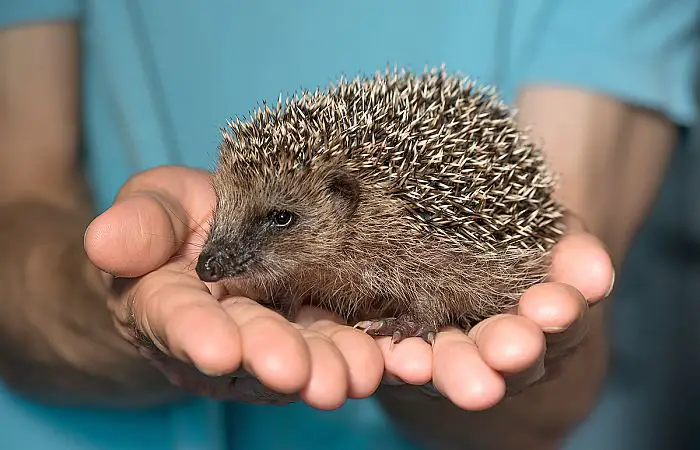A Hedgehog Hospital in Italian Wine Country
By Claudia Flisi
The lowly and low-slung hedgehogs of Italy face many threats. One vet is single-handedly saving the injured and giving them sanctuary.

Temptation beckoned on each side of the road. Vineyards to the left, vineyards to the right, softly rolling grapevine-flecked slopes delineating the horizon. I was driving through a town called Barolo, so no surprise.
But my destination was not one of the dozens of wineries in this area (286 in the province of Cuneo, where Barolo is located). I was headed to Novello, a tiny town bordering Barolo, for an experience unique in this country and impossible to find anywhere in the Americas. Novello is the location of Italy’s first hedgehog sanctuary, The Centro Recupero Ricci “La Ninna.”
The Center’s primary guests are Erinaceus europeus, the common European hedgehog. The popularity of Sonic the Hedgehog notwithstanding, Erinaceus europeus is not found in nature in North or South America. These prickly little creatures with black quills and pointed noses are exclusive to Europe and can be found across the continent, from Sicily to Scandinavia. Britain is so attached to them that it holds a Hedgehog Awareness Week every year.
I wanted to see a hedgehog up close, and—more importantly—meet Massimo Vacchetta, the veterinarian who is dedicating his life to their conservation.
Novello is a village of about 1,000 people. Its origins date back to Roman times but it appears as a medieval town perched atop a hill, with narrow streets, a cream-colored castle, squared no-nonsense stone buildings, tiled roofs, a few watchtowers, and limited parking. Nothing screams “tourist attraction” here because what you are getting is the Real Deal—Piedmont as lived by the locals.

A municipal parking area tucked away between the castle and the center was the best place to leave my car. Then it was just a few steps to the 17th century home that is both animal sanctuary and Dr. Vacchetta’s personal residence.
A buzzer beside the carved wooden door gave me access. Up to the second floor (what Italians call the first floor) and my first glimpse of Dr. Vacchetta was his back. He was sitting at a table hunched over something and invited me to watch him at work. He was feeding one of his charges, Musetta (meaning “little snout”), a two-year-old hedgehog whose nose had been sliced off by a grass cutter eight months earlier. Without treatment—antibiotics and hand feeding—she would have died within days. “But she seemed to have the will to live,” recalls the doctor, “so I decided to try and save her instead of euthanizing her, and she is still here. “
I watched as he fed her protein puree with a metal spoon, the excess (a lot) falling on a towel placed on the table for that purpose. Then he gave her a shiatsu massage, rubbing behind her ears, until she fell asleep.
With Musetta taken care of, Dr. Vacchetta focused his attention on me.

He is a boyish 52, with more than a passing resemblance to the English actor Hugh Laurie. He has a long face, a shock of brown hair, and pale blue eyes that reflect some of the pain of his shiny brown-eyed charges. His slender hands have cuts and scratches, since hedgehogs have formidable teeth (to aid in their consumption of insects and slugs).
Dr. Vacchetta began with the history of his involvement with hedgehogs. He is from Piedmont, and, after graduating from veterinary school, he spent 24 years specializing in bovine medicine. His life changed in May 2013 when he met Ninna. “This was a time when my personal life was in pieces. I had been focused on material things like clothes, cars, restaurants. My then-girlfriend had left me. I wasn’t satisfied with my work with cows, keeping them healthy so they could be killed and eaten. I became a vegan and began shifting my practice to small animals. One weekend I was substituting for a vet with a small animal clinic. Someone brought in a week-old hedgehog in a shoebox. Her helplessness and solitude touched me.”

A newborn may weigh less than an ounce; it is blind and totally dependent on the mother, who not only feeds it but helps it evacuate for the first two weeks by licking it. Eyes open at two weeks and teeth sprout at three weeks. Not till four weeks is the animal relatively independent.
Vacchetta knew this much but (like most of his colleagues) nothing about the care and feeding of orphans. So he searched for information online and found a knowledgeable hedgehog forum to guide him. He already realized that cow’s milk would kill a baby hedgehog; the forum experts advised a formula for puppies low in lactose and high in protein. He fed this to the hedgehoglet 10 times a day by medicine dropper. Sleep became an occasional option for him, but the baby thrived and Vacchetta was utterly smitten with his patient.
Copyright (C) Perceptive Travel 2018. All rights reserved.
- The Darker and Wetter Side of Bergen, Norway by David Nikel
- Kayaking the Calusa Blueway in Florida by Tim Leffel
- Trying to Find the Real Dubai by Debi Goodwin
- Travel Book Reviews by Susan Griffith
Books from the Author:

Buy Crystal and Jade at your local bookstore, or get it online here:
Amazon

